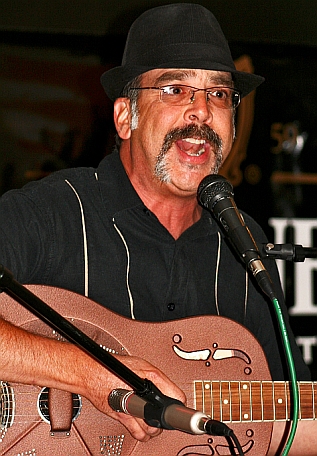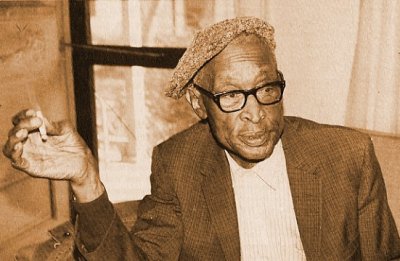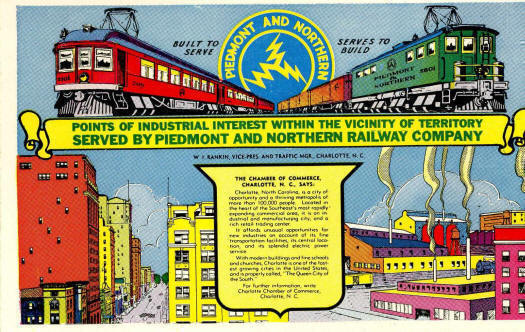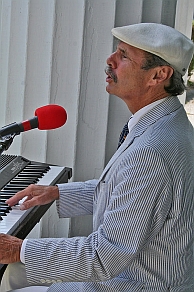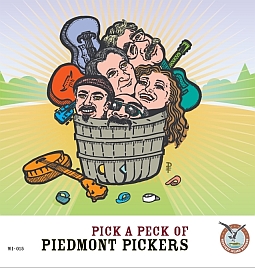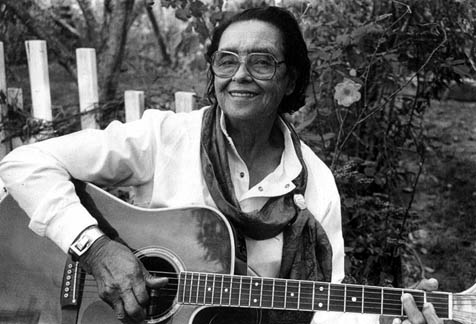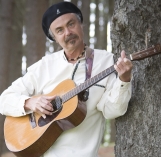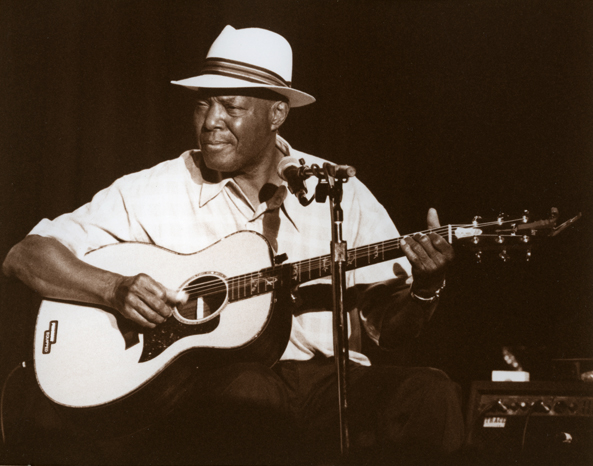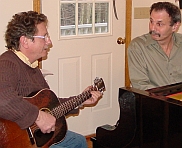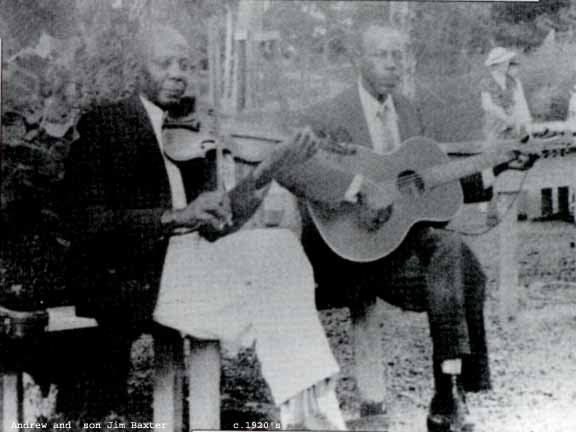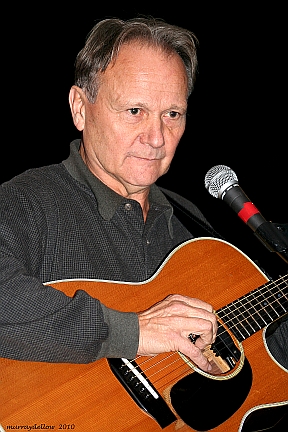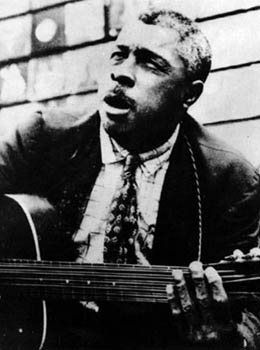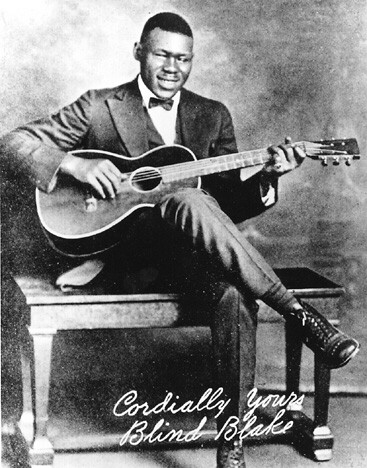

Click here to listen to Wepecket Radio for free!![]()
Liner notes for:
Click here to order the CD
Piedmont Blues: a brief historyThe name "Piedmont" refers to the region between the Appalachian Mountains and the Atlantic coastal plain where the style evolved. Geographically, the region describes a fat crescent from Maryland and East Virginia in the north to northern Alabama in the west, with its axis on the eastern slope of the Appalachian Mountains. Piedmont blues essentially translates ragtime piano to guitar. Also known as "East Coast Blues," or "finger-picking" style, it differs from the more widely heard Delta style in that the picking thumb plays a piano-like bass line on the guitar (usually alternating octaves or fifths). The melodic right-hand part is picked out, originally, by the index finger, this being a retention of African playing. During the 1960s Mississippi John Hurt (1892-1966)'s two-fingered style was copied so much by young revivalists that it now seems natural to play with thumb, index and middle fingers, but Rev. Gary Davis (1896-1972) and Arthur "Blind" Blake (1893-1933) used only the index finger. This style also differs from Delta blues in that the music is fitted for step dancing, rather than slow couple dancing. Traditionally played by musicians of African descent, the two-finger up-picking style made its way into White society both on banjo and guitar before the turn of the 20th century, and was widely used by both men and women of both races. Most of the cities in the Piedmont – Montgomery, Columbia, Charlotte, Greensboro, Alexandria and Richmond, for example – were prosperous trading centers, situated at the western-most navigable parts of rivers, where goods were exchanged and transferred from water to land transport in the 18th and 19th centuries. Most of these became important railroad hubs in the latter part of the 19th century and into the 20th. Those railroads, particularly the Southern Railroad, which was completed in 1893 and ran from Memphis to Washington, D.C., brought mass-produced "catalogue" instruments from Chicago, Philadelphia, New York and Boston, along with high button shoes and crank-wringer washing machines. The combination of relative wealth and active in- and out-migration contributed to the climate of sophistication, and allowed musicians to work as entertainers, in addition to playing music for their own and their friends and families' enjoyment. Pianos, rare in the rural Delta area, were ubiquitous in Piedmont cities and towns (Richmond, Baltimore and Greensboro all had thriving piano manufactories in the latter half of the 19th Century). Many of the seminal players – Blake (1893-1933), Bill Broonzy (1898-1958) and Tampa Red (1904-1981) among them – also played the piano. Davis often told his students that to play guitar properly you had to make it sound like a piano. The Piedmont playing tradition, which began in the early to mid-1920s, has been a long and unbroken one, with second-, third-, and even fourth-generation practitioners taking the older folks' place, including Etta Baker (1913-2006), Archie Edwards (1918-1998), John Jackson (1924-2002) and John Cephas (1930-2009). More current players include Larry Johnson (b. 1939), Roy Book Binder (b. 1943) and a host of other students of Davis and Baker, including the players heard on this recording. The very best of the Piedmont pickers, chief among them Blake and Willie McTell (1898-1959), played amazingly intricate bass lines with their thumbs (McTell on a 12-string, at that!). Listen for the piano-style bass lines, ranging from stride "bottom" to boogie-woogie, in these recordings. The playersAs a mediocre guitar picker myself, I've always admired those who have mastered this style of playing. As a piano player of some accomplishment, I also appreciate the guitar style's roots in ragtime and early stride piano (e.g. Leroy Carr (1905-1935), James P. Johnson (1894-1955), Georgia Tom Dorsey (1899-1993) et al.). I cover a fair number of Piedmont blues on the piano, and delight in telling the audience that if they listen closely they "Can hear my piano imitating a guitar imitating a piano." I'm delighted to have been able to gather such a distinguished and talented array of players: Andy Cohen, now living in Memphis, is also a scholar of the music and its cultural context, and is one of an illustrious few who have the "received knowledge" that comes from hand-to-hand transfer of the craft. He has made traditional American music his life's work, and is a frequent contributor to Sing Out! Magazine. He helped in the founding of the Mississippi John Hurt Museum in Avalon, Mississippi, and in running the annual blues festival there. Briefly a "lead boy" for Rev. Gary Davis, he has studied Davis's playing all his adult life. He also befriended and learned directly from Jim Brewer (1920-1988), David "Honeyboy" Edwards (1915-1911) and Etta Baker to name a few. He's a great teacher himself, so he is also passing the tradition on to a new generation of players – including Mike Higgins (see below). Gareth Hedges is a Southerner – from the South of England (Devon, to be exact)! Gareth learned traditional American songs as the road manager for many roots musicians from this country who were performing in Europe during the late '60s, '70s and early '80s. Bill Monroe (1911-1996) and the Bluegrass Boys, old-time banjo player Clarence Ashley (1895-1967), Gary Davis, slide guitarist Mississippi Fred McDowell (1904-1972) and blues piano player Curtis Jones (1906-1971) were among his mentors. His is a refreshingly light touch on the guitar – with a lacey melodic line to complement a rock-solid, yet syncopated bass. Mike Higgins' guitar playing has gone full circle – from early years spent admiring contemporary players like David Bromberg and Tom Rush and through them listening to and studying Gary Davis and Blind Blake – to two decades playing electric guitar in cover bands – to a reaffirmation of the masters who led him to the guitar in the first place. He's also writing material that's brand new, but squarely in the tradition (e.g. "Beantown Rag"). He divides his time among teaching and operating a small recording studio in his hometown of Taunton, Massachusetts, and performing both locally and nationally. Russ Mello studied for several years with Paul Geremia, himself a student and friend to many of the early players, Pink Anderson (1900-1974), Son House (1902-1988) and Howlin' Wolf (1910-1976) among them. In a way, that makes Russ a third-generation practitioner of the art. Paul once said of Russ's playing, "I can't show him anything more!" His version of Rope Stretching Blues illustrates Paul's point perfectly. Russ has also developed a terrific body of work from the tradition of the Memphis jug bands – who were also influenced by ragtime piano stylists. He currently resides in Mattapoisett, Massachusetts. Lauren Sheehan was a friend, student and disciple of Etta Baker, John Cephas and John Jackson, among others. They've all passed on now, but their music definitely lives on in Lauren's playing. Originally from New England, Lauren spent several years in Virginia learning her craft before moving to Portland, Oregon, where she now makes her home. Lauren first heard and began to learn country blues from National Heritage fellows and others in 1993 in Port Townsend, Washington, at the Centrum Country Blues Festival and workshop. Those players had direct links to pre-war acoustic blues from Piedmont to Mississippi and over the years passed on a lot of music, stylistic nuances and qualities as well as their cultural and social context. Her main influences from this group of players are Jackson, Howard Armstrong (1909-2003), Baker, Cephas, Algia Mae Hinton (b. 1929), Jerry Ricks (1940-2007), Phil Wiggins (b. 1954) and John Dee Holeman (b. 1929). About the musicCincinnati Flow (track 6; Traditional) You can make any number of guesses as to which piano rags inspired this Gary Davis virtuoso piece, but Joplin's "Slow Drag" is as good as any. Davis said that he learned it from his guitar playing pal, Willie Walker. This is a classic example of simple structure coupled with strong execution for best effect. The embellishments and ornaments are clever enough, but it's the syncopated two-feel that makes it such fun to play – and listen or dance to. We've inserted this cover that Andy Cohen and I cut originally for Four Hands No Waiting (WI-006), because it illustrates that point far better than words can describe it. I'll let the other players tell you about the other tunes in their own words. – "Ragtime" Jack Radcliffe Charlie Stone (track 1, Larry Johnson) This version of Bessie Smith's (1894-1937) "Trombone Charlie" was written by Larry Johnson. Larry, now in his mid 70s, possesses the best blues singing voice since Big Bill Broonzy (1898-1958). Originally from Wrightsville, Georgia, he landed in New York City during the '60s Folk Revival and fell in with Rev. Gary Davis, 78-rpm-record collector Nick Perls (founder of the Yazoo and Blue Goose labels) and a young stride piano player named Jack Radcliffe (founder of Wepecket Island Records), among other people. I've always loved Larry's way with a song, and I do the best I can with this one. I've always felt Larry should be much more celebrated than he is. The Glory of Love (track 14, W. Hill) Big Bill played fiddle growing up in Mississippi and Arkansas, moved to Chicago after serving in a construction battalion during World War I, and fell in with Tampa Red (1904-1981), the guitar player half of Bessie Smith's backup combo. (Her piano player was Tom Dorsey, who felt a religious call that came to a crisis around 1927, when he lost his wife and child, but that's a whole 'nother story). In any case, Bill was not a Piedmont player exactly, but Tampa Red was, so Bill's playing represents a sort of fusion of Piedmont and Mississippi styles of blues. He was the first guitar player who really fascinated me as a young schnook, and I took pains to get even his mistakes right in my learning years. Bill had two careers in music, the first as a highly popular and well regarded blues singer for the African American market (wrote almost 300 songs and recorded almost 1,000 over the course of thirty years), the second as a folksinger, starting around 1950. I hope this rendition of Glory of Love, which he recorded during his second career, measures up. Sure, it's a pop song, sung to please a largely folkie audience, but Bill put his personal stamp on everything he did. I played a few notes that he didn't, but then, Bill always said, "Play it how you feel it." –Andy Cohen Fishin' Blues (track 3, Traditional) This song can be traced back to the early 1830s when "Gumbo Chaff" was popular fare at minstrel shows. The earliest known recording in its current form was by Henry Thomas, in 1927. Joe Martin and Willie Brown recorded it for the Library of Congress in 1941, and it's been covered more recently by Taj Mahal and The Lovin' Spoonful. My version leans more toward the treatment by Doc Watson, both in terms of the guitar styling, and in the less bawdy handling of the lyrics. Many of the earlier versions leaned toward a heavy-handed approach to the double entendres, and some parodies are downright filthy. I prefer the family-friendly tone in this take. Good Little Thing (track 7, W. McTell) On the other hand, the lyrics of this Willie McTell tune are chock-full of obvious euphemisms and metaphors. "Georgia Bil" played it on the 12-string, but I heard John Jackson do it with a six-string, and I like the contrast between the lacy guitar accompaniment and the racy lyrics. Bell Buckle Rag (track 11, G. Hedges)) The town of Bell Buckle is just about smack dab in the middle of Tennessee, halfway between Chattanooga and Nashville. For a young Englishman newly head-over-heels in love with American country music it was Shangri-La, Nirvana and Mecca when I first stopped there as the driver for Bill Monroe back in the late '60s. It is home to the Louvin Brothers Museum and to the Bell Buckle Cafe and Music Parlor. It deserves a tune of its own, and now it has one. – Gareth Hedges Beantown Rag (track 4, M. Higgins) I wrote this piece about a year ago. I have always had a deep love of "true Travis picking." Most folks today have created hybrid versions of what Merle did. Chet Atkins took Merle's style of thumb and one finger and added more right hand fingers, but really kept the thumb mute technique and the bass accent the same. I based this piece on that style. The triad pulloffs are tricky, but they add the humor and sense of fun that I always get when I hear Merle. If you listen closely you can hear a trace of "Salty Dog" in there. The piece is my little amalgamation of influences over the decades. Chump Man Blues (track 9, A. Blake) This piece knocked me flat on my fanny when I first heard it many years ago. Blind Blake's ability to play it at the speed he did while telling a convincing tale was amazing to me. David Bromberg covers this piece at a slower tempo. Hearing him gave me the idea and confidence to take a bite of the apple. Blake is the undisputed king of Piedmont blues. The music he squeezed out of the "money position" has always been nothing short of miraculous. His sense of time and right hand technique is second to no one. Blake's playing and singing are the DaVinci code of the blues. – Mike Higgins All Gone Now (track 5, G. Yellowhammers) >I found this song one day searching around YouTube looking for some inspiration. I found a video of a fellow doing it on banjo and it grabbed me right away! I love when that happens. I always introduce the tune as a happy song about being miserable, and that it is! The Georgia Yellowhammers were a fiddle and vocal quartet from Gordon County, Georgia that recorded in the late 1920s. The group featured Charles Moody, Jr. (1891-1977) on guitar; Bud Landress (1882-1966) on banjo; Phil Reeve (1896-1949) on guitar; and Bill Chitwood (1891-1961) on fiddle. They were occasionally joined by Andrew and Jim Baxter on fiddle and guitar, respectively, who were Black, making the Yellowhammers pioneers in integration. The Baxters were a father-and-son duo noted for their version of K.C. Railroad Blues. Rope Stretchin' Blues (track 10, A. Blake) I think Blind Blake is the most incredible finger-style ragtime player in recorded history. The amount of music that he can make while rarely leaving first position chords is mind boggling. I have always loved this tune because of the first line, "I caught a stranger in my house and I busted his head with a club." Blake's lyrics have a light hearted wit about them. Even though that line seems harsh, it never fails to elicit snickers from the audience when I perform it. One of the few tunes he does that starts on a minor chord. Blake is THE master as far as I am concerned! Vamp of '28 (track 13, Whistler's Jug Band) I have recently been listening to a ton of jug band music and am trying my best to do it justice with my band The Ruckus Brothers. "The Vamp Of '28" is a tune that I loved the first time I heard it. It's by Whistler's Jug Band and they were one mighty band! I took the fiddle lead and transposed it to guitar. I love the stop between the verses. It's a fun tune to play and always gets a great response because of the story it tells. – Russ Mello Georgia Bound (track 2, A. Blake) This is a hybrid version of a Blind Blake song I learned from John Jackson around 1998. Recently I shifted it from his key of E to Blind Blake's key of C and added a bit more of Blake while keeping the feel and general style of John Jackson's versions alive. John was a songster, a fine Piedmont player from Rappahannock County, Virginia who was born in 1924 to a musical family. His fluid shifting from blues to folk to swing and even fiddle tunes on banjo was influential to my own musical evolution. That's No Way to Do (track 8, Traditional) Another one I learned from John Jackson. It was really a pleasure to hear him sing "Music man, play that thing" and the minstrel-like patter he would add over the guitar riffs. I remember a long hour working on that piece with him ... "long" because his manner of teaching was to just play things "as many times as you want." But he wasn't so good at breaking down sections precisely, so I had to have all my learning antennae engaged. Spike Driver Blues (track 12, Traditional) This is a finger-pickin' blues, influenced by Mississippi John Hurt's Spike Driver Blues in an easy back porch style. This version, with fretless banjo and guitar, is a good example of a contemporary Piedmont approach in which the voices stick fairly close to the melody and each other. I think we hear how old banjo picking could have easily led to early guitar picking styles. Greg Clarke, who also lives in Portland, is the banjo player on this track. –Lauren Sheehan CreditsTracks 1 and 14 recorded by Matt Isbell, Memphis, Tennessee Tracks & Times1. Charlie Stone ( L. Johnson) 2:00 |
--------------------------------------------------------  © Copyright 2003-, Wepecket Island Records, Inc. All rights reserved. Host your web site with IPOWER! |














